
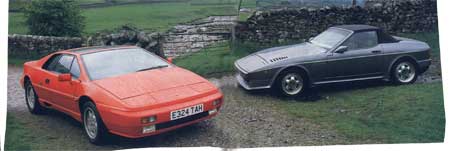
BLOW by BLOW
If the latest Lotus
Esprit Turbo personifies smoothness,
then the new TVR, complete with shrieking supercharger is the ultimate
rough diamond
Performance Car, August 1988
by Kevin Blick
To the already nape-tingling rumble of the TVR's V8 has been added a new sound. A sound like a circular saw tearing into a piece of timber, a low metallic howl rising to a shriek. It is a sound you won't have heard before – not unless you're old enough to remember the days of Blower Bentleys and 6C Alfa Romeos – for it is the uninhibited roar of a supercharger spinning up towards its 15,500rpm peak!
In the Lotus you had to listen hard to detect the engine at all. A faint whistle and a half-smothered gasp of released pressure were the only sounds heard from the hard working turbocharger behind the driver. Such were the aural contrasts in this blow by blow, supercharger versus turbocharger, comparison.
Lotus, whose Grand Prix pedigree is second to none (even though they have enjoyed little success in recent seasons), are in this context the engineering gourmets – in the delicate nouvelle cuisine style perfected by their founder, the late great Colin Chapman. In TVR's case, the reputation is still to be made – though in their search for greater power and speed through ever bigger capacity they have thrown mere engineering requirements to the wind! Theirs, by contrast, has been a rich diet of raw meat!
Now the animal appeal of the TVR, all thunder and raw edged power, has been boosted still further by that shrieking Sprintex supercharger. While the Esprit Turbo's brilliantly conceived but awkwardly hard edged Giugiaro original has been superseded by svelte new designer-elegant curves. Even the weather played a hand, typically offering us two mercurial days at the opposite ends of the meteorological spectrum – with opinions on the two cars under scrutiny changing accordingly.
Thursday afternoon had been wet and misty. The powerful Dales landscape remained half-hidden from view, its peaks cloaked in romantic cloud, the valleys softly highlighted by rain mellowed greens and browns. In such circumstances the TVR was sadly lacking. Hot, stuffy, noisy, harsh riding and perpetually steamed up, driving it in the wet weather degenerated into something of an ordeal for which there were no eager volunteers.
Then Friday morning dawned bright and clear. The TVR's clever hood was down in a moment and all that had been worst about the car the previous day appeared to be exorcised through the newly opened top. Suddenly the TVR was a delight, the rumbling echo of its exhaust lost across a thousand acres of spectacular emptiness that the sunshine had revealed to view. Man, machine and mountains seemed to be combined in perfect harmony.
And what of the Lotus Esprit? Cosseted cosy and comfortable against the rain, we had cruised north up the busy A1, marvelling at the reduction in cabin noise levels. That wind and road roar was gone; the engine so close behind our heads had been silenced. The ride, too, was supple and smooth – always a Lotus strength.
The sun came out as we journeyed through the lanes, but there was sadly no soft top to lower (though there was a large glass roof panel to lift up or out).
Sitting – almost lying – in the low-slung cabin, visibility was poorer, with crests and dips harder to read. And though the quiet turbo engine worked well, with as little lag as any of its competitors have managed, it still couldn't match the instant response of the wailing TVR. In short, where the TVR had veered between extremes of triumph and disaster, the Esprit simply behaved like the polished professional it now is. Maybe the peaks of triumph weren't quite so high, but then neither, too, did the troughs of disaster run so deep...
They are unlikely competitors, you might think, the Lotus and the TVR. But neither has quite achieved the elite status of the metal bodied exotics; they have formed rather a sub-supercar class. Indeed, at £29,950, the new Esprit Turbo, with its sophisticated mid-engine layout and smooth new looks, does appear something of a supercar bargain.
The angular and mechanically conventional TVR convertible is less obviously in the bargain category – until you start comparing power and performance. For both the beefy 390 SE and the red-raw 420 SEAC models can comfortably out gun the delicate Lotus. But stretching the dimensions and horsepower of the original Rover V8 make it progressively less the easy-going rumbler and more the fierce but tetchy half-race unit.
This time round, however, what we had was a TVR – in the shape of the new supercharged SX350 – that threatened to combine all the traditional flexibility of the 'soft' V8 with Lotus eating horsepower and torque!
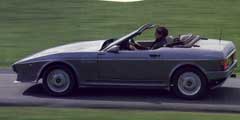
Though the supercharger's role as the premier method of improving horsepower through forced induction was usurped by the turbocharger many moons ago now, the supercharger nevertheless survives and is starting to thrive once again.
The turbocharger is, of course, exhaust driven. Neat in principle, it uses waste exhaust energy to drive a turbine which, in turn, compresses intake air. But in practice there are problems of complexity, heat and lag. The supercharger is an engine driven compressor; installation is simpler and there are no heat or lag problems. Sounds good, doesn't it? The SX350 puts principles into practice using the unique Sprintex system in a conversion developed by Yeovil-based DPR Engineering for Haughins of Barrow-in-Furness, TVR's northern centre. In doing so, it adds £3968 to the £18,015 of the standard 350i.
The Glasgow built Sprintex is a screw type compressor, a toothed belt taking drive from the nose of the V8's crankshaft to turn a pair of helical rotors. Having different pitches, these progressively compress the air as they draw it in and through the compressor. A relatively mild 6psi of boost demands not internal changes to the engine, save thicker head gaskets which reduce the compression from 9.7 to 9.2:1. Power increase from the 197bhp of the standard 350i's V8 to around 250bhp at 5000rpm, while torque is up to 275lb at 3800rpm.
The only other changes to the standard 350i Convertible were the bigger brakes and the adjustable gas dampers of the 390 SE, which Haughins recommend as a complementary handling package (costing about £1200). Otherwise the SX350 specification was familiar: hand laid up glassfibre body over multi-tube chassis, double wishbone and coil front suspension, lower wishbone and drive shaft-cum-upper-link rear suspension. The rack and pinion steering had optional power assistance on our model. In all, it is a simple but effective formula and ideal for a low volume car that is, by and large, built by hand. The Lotus has similar roots: swop the multi-tube chassis for a spine one, the TVR's rear end for one of transverse links and radius arms, and you've a not too different version of the same formula!
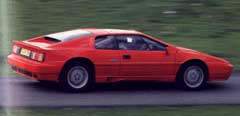
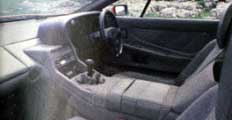
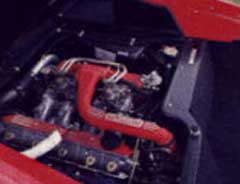
But sophistication has gradually superceded simplicity at Lotus. Bodies are no longer hand laid up but formed by partially automated vacuum-assisted resin injection. The two horizontally split halves are built separately and then bonded together before painting. And the Esprit's engine is the company's own 16-valve, 2.2-litre twin-cam, now fitted with the latest water-cooled Garrett T3 turbocharger, which blows through a pair of pressure sealed Dellorto 45s. There's no engine management or even an intercooler, incidentally, and power is unchanged at 215bhp at 6000rpm, with peak torque at 220lb ft at 4250rpm. The unit is mounted in-line close behind the driving cabin and feeds power to a transaxle that is newly sourced from Renault (it's the GTA unit). Brakes are all disc, ventilated at the front, and the rack and pinion steering is unassisted.
The different standards of engineering and manufacturing sophistication come over strongly. The TVR is a simple, no-nonsense machine – a classic British roadster if you like. But not necessarily any the worse for that. In its light body the V8 can paint the road with great daubs of power and torque. It's an engine of seemingly quite effortless power – feeling almost lazy in the higher gears – but certainly no laggard in the lower ratios, either, where a floored throttle brings instant, roaring response. And that's the crucial difference between the respective engines. The TVR's is pumped full of torque – so much so that even a gentle getaway has the rear tyres chirruping on the road. The supercharger hasn't created this – it has merely reinforced it! Behind the deep throated exhaust, the background shriek of the Sprintex blower has risen in pitch to its peak, a barely audible whistle before half-revs, dumping all that extra torque right where it's most wanted.
The result is a superbly useable engine, whose ultimate ferocity is cunningly disguised by its massive flexibility. But fierce is certainly is: acceleration is stunning as the rumble turns to a bellow and then a roar. At the test track all the 20mph increments between 30 and 100mph were demolished in just over four seconds in fourth gear, and between 6.5 and 7.6 seconds in fifth, illustrating the engine's flexibility. But standing start times were disappointingly little different from those of the standard 350, with 0-60mph taking just 0.1 seconds less at 5.9 seconds and 0-100mph taking a still blistering 14.2 seconds. This was due to the test car trying to pump all that muscle through a set of badly worn rear tyres which is spun as soon as power was applied. The non-standard, high geared 390 differential on this car would also increase times.
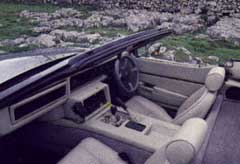
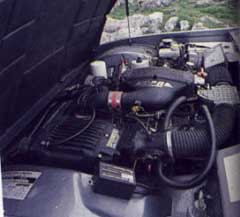
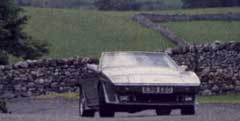
It is a thoroughgoing contrast to the Esprit. The Lotus turbo engine was once unquestionably the best of that breed. It remains among the cream but others now have learnt the turbo tricks, so it no longer has the field to itself. Not, you begin to notice the shortcomings. There isn't – there can't be – the immediate response of the big capacity supercharged TVR.
At lower revs, before the Garrett has build up speed, the engine feels soft and mild – even docile sounding with its slightly clattery four-cylinder beat. Like all turbo's, real response is saved for the mid range when the Esprit fairly begins to fly and, in its deceptively quiet way, to real in the noisy TVR. Revving to a still smooth 7000rpm, the long legged Esprit builds up speed impressively and, ultimately, thrillingly as it rushes towards a 153mph maximum that is outstanding for such a small engined machine. Yet, even though standing starts acceleration is just as noteworthy – with 0-60mph taking only 5.2 seconds – and even though the turbo installation suffers minimal lag, flicking back up to positive boost the instant the pedal is floored, driven back to back with the TVR you continue to yearn for the honest muscle of a big capacity engine.
Each of the pair has a tiny gearstick sprouting from a high centre tunnel. The TVR's prods quickly and accurately through a well defined gate, while the Esprit's Renault-based shift is equally quick – although the second gear slot is far less well defined.
Engineering is more than engines alone, though, and the Lotus's finest shot is its chassis. There's a balance of stability and suppleness in it which is rare. It is taut and stable, unworried by surface changes or irregularities. Instead, it tracks straight and true, then responds instantly to the flick of a wrist that sets its course through a fast, sweeping curve. The roll free chassis seems to make few demands of the NCT tyres (195/60 front and 235/60 rear) and you can corner hard without breaching its natural neutrality and have the front end begin to drift wide. The car is less happy on the really tight stuff: the steering becomes much heavier on extremes to lock and the brakes are rather too sensitive for the light check stops often needed.
In any other company the TVR's handling would be impressive enough to carry off the honours. Again, the car is beautifully balanced in the classical rear drive style, moving from initial, warning shot understeer to inevitable oversteer – with its hefty 225/50 Bridgestone RE71s to give massive cornering grip and to help restrain the huge V8 torque.
But on fast roads, the low profile tyres thrum noisily and on the bumper stretches the damping control isn't quite a match for the Lotus, and though the TVR is stiffer sprung so that it rides more harshly, it also bounces and pitches rather more too. And the exhaust bottoms expensively over relatively small crests. Steering on the TVR is perhaps a happier compromise than on the Esprit. Gearing is a little lower, so initial response is not so lively but the (admittedly assisted) system maintains a more consistent weight on lock and is less physically demanding. Brakes, too, are more progressive in action. Sports cars both, each has an uncompromising two-seater cabin, with a pair of leather clad seats wedged between a deep, wide, centre tunnel and a broad door sill. And in each, the driver sits low, with little view of the bonnet ahead, legs and arms stretched.
But there the similarities end: the TVR's is a simple interior, expensively though not very tidily trimmed in wood and leather, the Esprit's a far more stylish one, with chic looking one piece seats and a revised version of the original wrap around instrument binnacle.
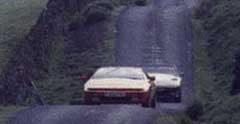
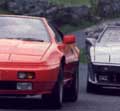
Both are fully instrumented (and with identical VDO dials) and both have had to raid the parts bins of the major manufacturers to find appropriate stalks and minor switchgear. In the TVR this tends to show, while what has been done in house – like the flimsy heater slides – stands out like a sore thumb. Lotus have picked better from the all-sorts packet: their switchgear looks right and works well.
But neither car can make great claims for cabin ergonomics. The Esprit's footwell is not tiny and its pedals far too cramped. Even being careful, we were frequently catching modest size eight feet on two pedals at once. And while the seats look good, they lack side support – so drivers need to be broad enough to wedge nicely between door and tunnel when cornering. Drivers of six feet or more will find legroom sorely lacking and the gear lever positioning awkward – the Esprit's is a cabin best suited to those of more modest proportions.
An overriding complaint, however, is poor visibility. That view forwards is now much improved thanks to slimmer A-posts, but over-shoulder vision is impossible and it's hard to see much out of the small rear window either, because of internal reflections and paint glare between that, the sloping glassback and the engine lid.
The simpler TVR interior scores higher on basic ergonomics – pedals are larger and better spaced, for instance – but poorly elsewhere. With the hood up, the rear quarters are obscured, and as we said at the start, in wet weather it's not fun at all. The plastic rear screen mists up easily, with no means to demist it, and the heating on our car proved incapable of demisting the front screen, even while suffocating the cabin (a look under the bonnet suggested that the reason might have been the removal of some trunking in order to route the new intake system). The Lotus heating is no great shakes either, being a crude old, inaccurate water valve system, but it does at least work and can be adjusted. In bad weather, the TVR is noisy, stuffy and best left at home if you have an alternative.
Thankfully, that ingenious roof does fold down very quickly: flip the over-centre stays to release and lower the rear hood panel, then lift out and stow the targa roof section in the boot. The Lotus has a large, lift out roof panel and ours was in glass (an option) – which added welcome extra lightness to the interior.
In each car, stowing roof panels does eat into limited stowage space, of course. The TVR has a small conventional boot plus a sizeable shelf inside behind the seats. The Esprit has surprisingly usable amount of space in the rear, behind the engine – though almost none under the bonnet where you might have expected some. Inside, it's hopeless, however. There's nothing save a small glovebox and bin between the seat backs, neither of which can be reached on the move: you even have to stow your jacket in the boot! And for a costly car, the Lotus annoyingly misses central locking from its standard spec – a particular nuisance in such a wide, low car.
But finally, what of the contrast in manufacturing sophistication we mention earlier? More even than in style and performance, it's in this area that the new Esprit excels. A fresh quality is evident from your first look at the latest Esprit Turbo. Not only is the shape more subtle and cohesive, but there seems a new integrity about the fit and finish – the fire engine red paint gleams with a deep, pure shine, while panels fit with unerringly straight edges.
Inside the Esprit, it's a similiar story. The leather and tweed cloth trim no longer has that self conscious plush look of so many small, up market producers but instead has the tight fit and confident execution of a serious production car.
If only it were the same for the TVR. In fairness, we are comparing what began as an £18,000 car against a £30,000 one – though the gap swiftly closes when you compare different models in the respective ranges – but the TVR has shortcomings which ought not to be there at almost any price. The fit of the panels is poor, and matching is bad: the bonnet follows a different curve to the wings, the door windows sit at a different angle to the screen. Even the basic glass-fibre work on ours looked poor, with noticeable rippling in places. It's an exciting machine, true enough, but sloppily executed (even one of the uni-directional Bridgestones was fitted the wrong way round on our car).
With their new Esprit, Lotus have grown up. At last the car has a maturity of style and quality to match performance and handling standards that were never in doubt. The TVR continures to struggle to achieve the same goal. The performance is certainly not lacking – and in the Sprintex version a remarkable new dimension has actually been added –and nor do handling and roadholding give anything away to front-engined rivals. But what's missing is a refinement to match the excitement – that quality that could make the TVR a delight to own as well as to drive.
But what we haven't said either is that the TVR is still the battling Blackpool independent, where Lotus have the financial might of General Motors behind them. And the difference clearly shows.
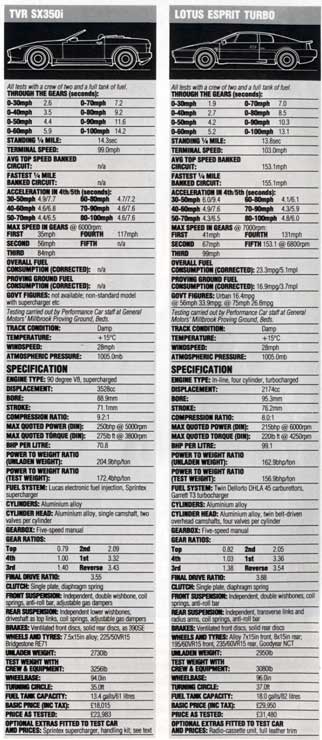
|
|